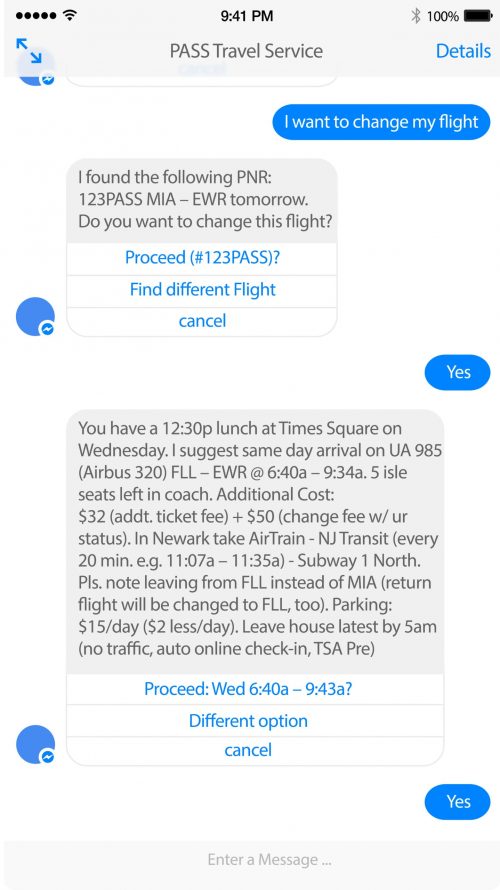What is a chatbot? A chatbot is a service powered by rules and sometimes artificial intelligence (AI), which you interact with via a chat interface. An example: If you need new shoes, instead of going to the store and talking to the salesperson about what you want or scrolling through all shoes on a website, you would simply tell the chatbot what you want: your size and your preferred style. Then you would get returned the results as if you were in the store. Chatbots are supposedly huge because for the first time in history, messaging apps have surpassed social networks with over three billion active users per month (almost ½ of the world’s population).
Why would I want to chat with a machine?
If you are like me, you would think: In what ways can chatbots revolutionize the way we live? I’m forty-something years old, text less than ten messages per day and spend the better part of my day on the phone or writing e-mails in front of a computer. Even my kids do not educate me (yet) on how things are done in a modern world. For online purchases, banking or travel I either use my laptop or an app. I never use any chat function at all. So why would I want to chat with a machine?
I rarely ever use Siri and am always amazed by her lack of intelligence: “Siri, is it raining?”, I ask when a thunderstorm is passing by. “I don’t believe it is raining”, she responds. I say: “Well, it is!” and she goes: “Here is what I found on the web about ‘well it is’!” Seriously – why don’t you just put things into context and learn so that others will have a better experience in the future?
But then I remembered my brother-in-law controlling all the lights in his house with Amazon’s Alexa along with his Apple TV. I spent a fortune on intelligent light switches and still have to get up to change my light or tap into an app – which is still quite a few clicks just to find out that I was logged out in the meantime. As one can tell from the numbers, the younger generation spends hours on WhatsApp and other messenger functions, so there is a transformation happening. I guess I’m just not tolerant enough.
Chatbots eliminate the uncertainty and misunderstanding of voice
But then it hit me: the only way speech recognition and verbal man-machine communication can really succeed is through chatbots. In order to make man-machine communication efficient and reduce frustration, you need to include artificial intelligence. The machine needs to learn from speech patterns and this won’t be successful if there stands a verbal speech recognition uncertainty in between. Nobody is going to listen to endless communications with dialects, background noise, etc. to figure out what was said and how the machine can learn from it. With chatbots, you eliminate this uncertainty and misunderstanding of voice. This is why the Big Five internet companies (Google, Apple, Microsoft, Amazon, and Facebook) will put billions into chatbots in order to fill their databases with real world speech patterns to learn from besides efforts by IBM to promote its flagship platform Watson. How do people communicate? Once the machine knows – through the help of chatbots – the pattern of what is usually said, it will also better understand if real voice is used. And this is beside the fact that with chats you also have a record. And a chat can always be handed off to a real human – an agent – without the user having to repeat all the previous information. So the goal is that you will be one day able to talk to your personal digital assistant. The way to get there is through chatbots.
One input mask instead of a countless number of apps
How many apps do you have (or use)? Banking, travel, Facebook, text messaging, WhatsApp, phone, e-mail, reminder, entertainment (record this show, play Amazon Prime music, play my songs), news, research, home control – just to name a few. All these are different apps you need to open, put your information in, then save your preferences, worry about privacy, and go back and forth. Wouldn’t it make way more sense if you just had one input mask which controls everything? I’m on my way home: instead of using all those different apps, to just say “Can you turn on the AC at home, navigate using the fastest route, pay my credit card bills in full, remind me to book a trip to New York, call John, and once finished play relaxing music”? Or even better in regards to travel booking: just go through the options while you drive, taking information from your calendar, frequent flyer information, personal preferences and company policies into consideration as well. Isn’t this the reason why Google became so famous, because it didn’t have numerous blinking and confusing screen elements like Yahoo! used to have?
That’s when I realized that there will be a huge movement over the next couple of years in this area – and I believe that there is a good chance that it all will be triggered by chatbots – not because they are such a great medium of communication but rather because they are needed in order to create the next generation Cortana, Alexa or Siri.
A good time to experiment around
What does this mean for us? If you want to build a business online, you want to build where the people are and these days this place is inside messenger apps. A huge number of chatbot containers will come and go, however, eventually some will succeed (most likely when acquired by the Big Five). With all the data collected, the problem of transforming unstructured speech/chat into structured data will be solved. So you want to be there when the time is right. This means now is a good time to experiment around.
So we decided to help out with our expertise: While chatbots will soon be able to retrieve required information to e.g. create a booking, the actual creation of a Passenger Name Record (PNR) will not be so easy. Our financial arm has also analyzed chatbots for the financial industry and we will share our findings.
In anticipation of an increased demand of value-added travel middleware and backend capabilities coming from numerous travel chatbots, we gave out a directive to completely separate the user interface layer from the business logic so that any of these great new chatbots as well as any other user interface can use our proven travel shopping, booking and changing capabilities. Our approach for our “Travel Middleware”, using JSON as interface dialect, seems to be in line with modern Web application architectures and in essence the shift of all the user interface (UI) logic form the server to the client. This should give our clients the cutting edge to innovate with travel services. We expect our Travel Middleware on top of our Travel XLM API both to “live” for decades and support many generations to come.
While rule-based chatbots will bring you to your first prototype, what you really want to achieve is a chatbot using machine learning technologies which continuously gets smarter as it learns from conversations. There have been advancements in the area of artificial intelligence, so that you do not have to be an AI expert to incorporate some level of artificial intelligence. Let the containers do this work for you. Example platforms include: Facebook Messenger, Slack, Discord, Telegram and Kik. Example services include: Wit.ai (Facebook), Howdy’s Botkit, Api.ai, TextIt, Motion AI, Chatfuel, IBM’s Watson, Beep Boop HQ, Dexter, Converse AI and Gupshup. Helpful reading can be found on Facebook, Botlist, Botwiki and Mockuuups.
Possible scenarios for the travel industry
A typical example of travel could be: “I want to change my flight”. If the chatbot is tightly connected to the travel framework it should know the trips booked and can respond “Do you want to change PNR 123PASS from Miami to Newark tomorrow?” Next steps would be: Proceed, clarify the date, and select the alternative flight. Further integration with, a calendar function, your home location, maps, and your personal travel data could even trigger more specifics in less steps. The bot could even proactively ask the user when a meeting change was detected that trip details (hotel, car, flight) need to be changed as well. This brings me to my idea of a mobile travel app already years ago: My phone detects that I’m stuck in a meeting, knows the traffic condition to get to the airport, realizes that there is no alternative to make it home tonight, books me a hotel, and changes my flight to tomorrow, and all I need to do is to confirm.
If I get such valuable information, I may also be more tolerant to response times: While ten years ago people waited eight seconds for a website to respond; today they click away after two seconds. Response times the travel industry can only dream about. Travel related searches are rarely complete even within eight seconds (most of the time used on GDS side). Another beauty of chatbots is that there could be a handover to a “real” TMC agent at any time if the conversation is stuck – however, the agent knows already the history then.
SAP’s Concur recently acquired Hipmunk as apparently they felt they will not be able to keep the pace with consumerization. The major aspect in my eyes was their experience in AI and bot technologies.
In 2000 we had the first Travel XML API, in 2001 the first mobile-travel service, in 2003 the first graphical Agent Desktop, in 2010 the first rule-based Online Booking Tool and now we want to be the first to open travel booking capabilities as a middleware business logic layer to any kind of service including chatbots – stay tuned.






This Post Has 11 Comments
Hey, very nice site. I came across this on Google, and I am stoked that I did. I will definitely be coming back here more often. Wish I could add to the conversation and bring a bit more to the table, but am just taking in as much info as I can at the moment. Thanks.
Hey, very nice site. I came across this on Google, and I am stoked that I did. I will definitely be coming back here more often. Wish I could add to the conversation and bring a bit more to the table, but am just taking in as much info as I can at the moment. Thanks.
Great Post! Thanks for sharing with us and your blog design is excellent! Very informative for us.
Thank you! I appreciate your nice words.
All the best,
Michael
That was a great discussion on Chatbots – the Biggest IT Revolution after the iPhone?. The content of the article is really great.
Chatbot platforms such as Chatfuel, Botsify, Bottr help individuals to create a bot that fit their needs and business strategy. These all make the business easy to connect with and clear your concern and take the services
Thank you for your comment and additional information. Pls. always keep in mind, when it comes to shopping, retrieving and booking travel in or from the GDSs and other sources, instead of integrating yourself, talk to us first. We are the experts when it comes to multi-GDS integration as that’s what we have been doing since the year 2000. Many of our clients (even on a single GDS) provided feedback that we made their life so much easier and the time-to-market cannot be beaten. Check out https://xx1.pass-consulting.com/ to learn more. We have even developed a new REST interface which we will release in 2018. I don’t want to brag, but I want to make sure you make an informed decision. Many of our clients tell us ‘had I just known before integrating the 1st GDS’ – additional GDSs or a switch then become only a matter of days (you still need your GDS contracts though – no access to content without an agreement with the GDS!).
Very well written – bots will be the primary interaction channel of the future and holds a lot of promise against current and traditional formats. The challenge is to make the interaction design more intuitive, demystify the tech / engineering side to bring it into more acceptance of the masses by displaying value, and increase utilization for business cases. The 24×7 self service and intelligent nature of the format is already being used for customer service, conversational commerce, health tech and education. We have started on the journey at Engati, do visit us to give us feedback on engati.com – you can also read our collection of blogs on http://blog.engati.com/
AI chatbots are really helpful now a days and become a trending topic also. Today AI chatbot technology play a vital role in lives of humans & also creating a relation b/w Humans & technology. It’s interesting to understand, how AI chat bot technology is changing the Humech bond.
Agreed with regard to Siri, Cortana and Alexi! However, in order to make them to become better and more predictive, I believe you need chatbots .. and that’s why the big 5 will push them to success (for now).
Chat bots will disappear faster as they appeared. In a few years from now it’s all handled through Siri and Cortana – as part of the OS (iOS, OSX, Windows 10). I don’t want to go to a chat window and tell the system that I want to change my flight when I have an entry in my calendar. Ideally I open my calendar item and do a change request, like I reschedule a meeting. That’s integration. Using chat bots is not much different from using entries on an Amadeus terminal, except that the work moved from travel agent to end user.